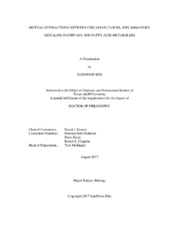| dc.description.abstract | To examine mutual interactions between key mediators of inflammation and circadian clocks and their role in diet-induced metabolic disorders, we first determined whether circadian rhythm desynchronization exacerbates high fat diet (HFD)-induced proinflammatory and metabolic responses. In mice exposed to shifted light-dark (LD) cycles, the disrupted entrainment of circadian behavior and modulation of peripheral clock function was accompanied by further amplification of HFD-induced adipose tissue macrophage infiltration, proinflammatory M1 activation and cytokine expression along with corresponding increases in the severity of insulin resistance and glucose intolerance. Feedback modulation of circadian clock by diet-induced inflammatory signaling was next examined by determining whether HFD and different fatty acids alter fundamental properties of circadian behavior and peripheral clock gene rhythms in conjunction with their proinflammatory effects. The anti-inflammatory, polyunsaturated fatty acid, docosahexaenoic acid (DHA), had negligible effects on circadian rhythms. However, prolonged treatment with HFD or palmitate, the prevalent proinflammatory saturated fatty acid (SFA) in HFD, modulated suprachiasmatic nucleus (SCN)-regulated behavioral rhythmicity and peripheral clock gene rhythms, inducing small increases in free-running period of the activity rhythm and substantial lengthening (3-9hr) of the period of clock gene rhythms in macrophages, fibroblasts and differentiated adipocytes. Following acute treatment, palmitate had little or no effect on the phase of the activity rhythm but induced time-dependent phase shifts of clock gene rhythms in cultured fibroblasts and iii differentiated adipocytes. The time-dependent phase shifting effects of acute palmitate were contemporaneous with rhythmic changes in palmitate-induced inflammatory signaling (NF-κB and IL-6). DHA and other inhibitors of inflammatory signaling repressed palmitate-induced proinflammatory responses and phase shifts of the fibroblast clock. Acute treatment with the proinflammatory cytokine IL-6 mimicked the peak phase shifting effects of palmitate alone and blockade of TNFα signaling using a neutralizing antibody repressed palmitate-induced phase shifts, suggesting that SFA-mediated inflammatory signaling via these proinflammatory cytokines may feed back to modulate circadian timekeeping in peripheral clocks. These findings suggest that key mediators of inflammation and inflammatory signaling may play a role in the mechanism by which HFD and SFAs modulate clock timekeeping properties, and in turn this dysregulation of circadian clocks exacerbates diet-induced systemic insulin resistance and glucose intolerance. | en |


